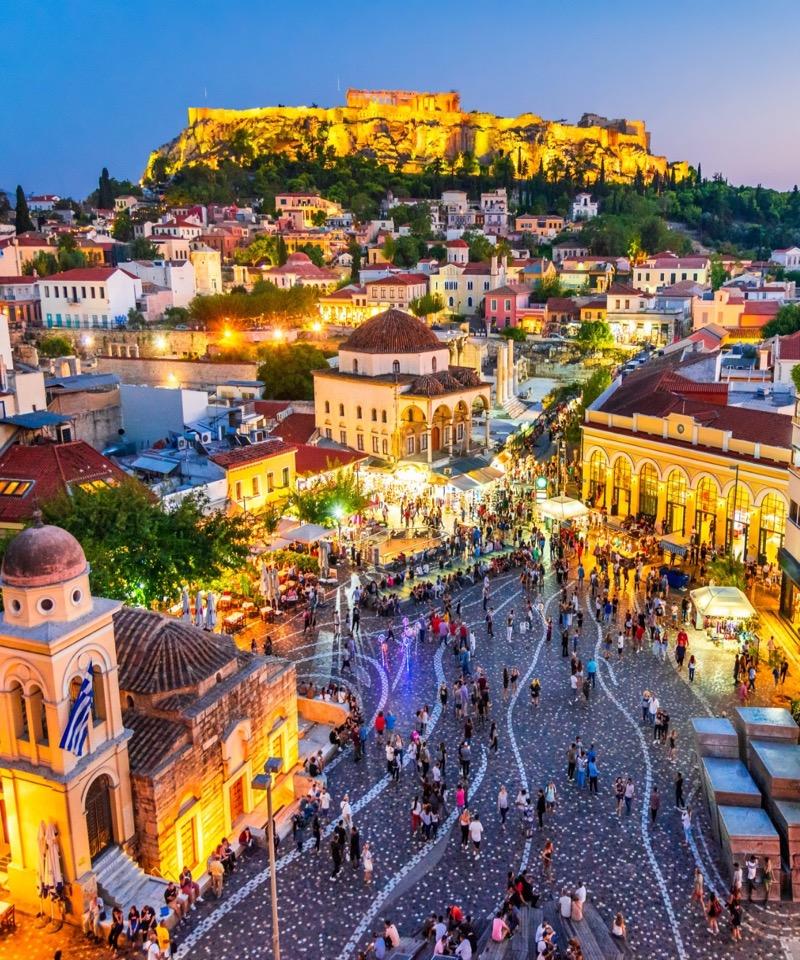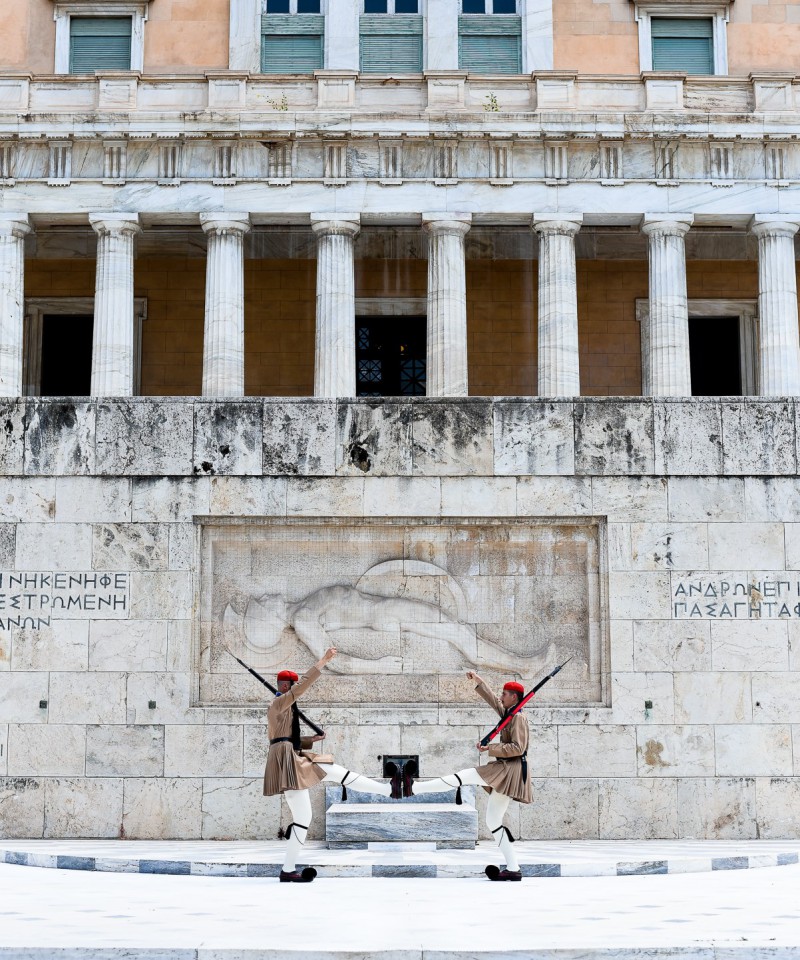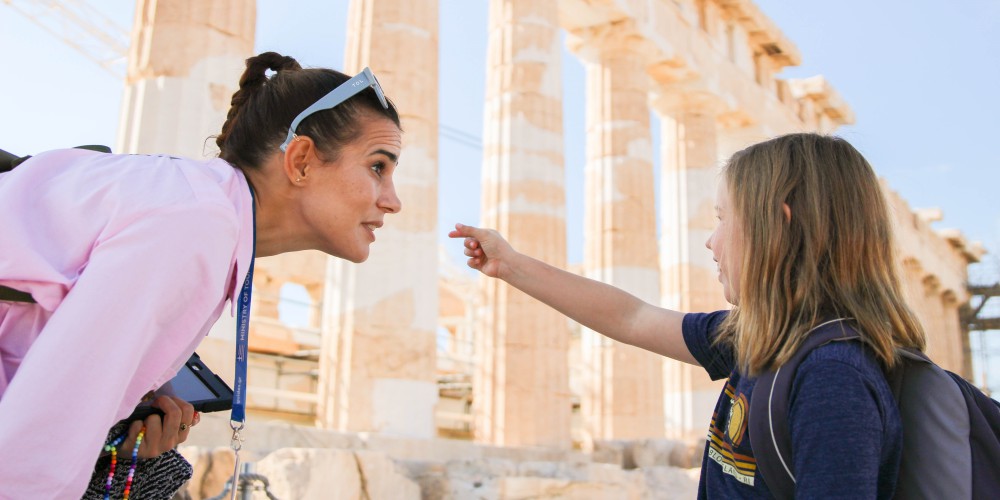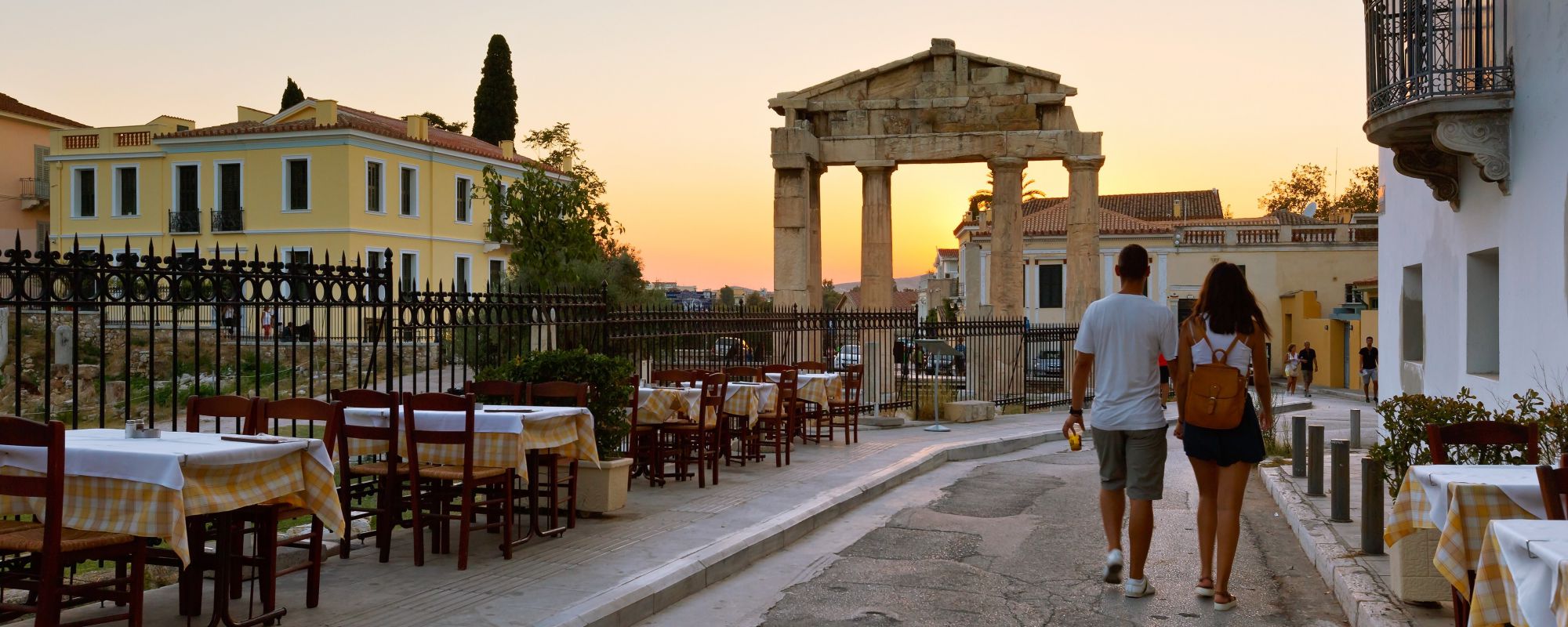
Where to Stay in Athens | Exploring Athens' Neighborhoods
Key Takeaways
- Each of Athens neighborhoods offers its own unique atmosphere, Athens attractions, and experiences, contributing to the city's vibrant and multifaceted character.
- Plaka is one of the oldest neighborhoods in Athens and is known for its charming, narrow streets, neoclassical architecture, and traditional tavernas.
- Monastiraki is a bustling neighborhood known for its lively flea market and street art. It is a vibrant area with a mix of old and new, where you can find everything from antiques to modern streetwear.
- Koukaki neighborhood is known for its hip and relaxed atmosphere, pedestrian-friendly streets, and various hip cafes, bars, and restaurants.
- Kolonaki is a fashionable area popular among the city's affluent residents and visitors seeking luxury shopping experiences and a luxury hotel to stay in.
Athens is a fascinating big city with a plethora of places to visit. Exploring it might seem like a daunting task, but that's why we're here for.
Here is an overview of Athens neighborhoods and key points of interest apart from its archeological sites to make your stay in the city a breeze!
Athens' Neighborhoods
Plaka
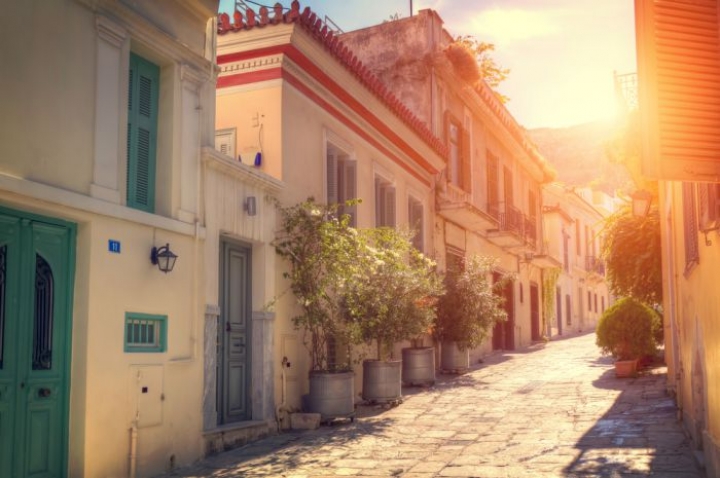
Do you want to travel back in time right in the center of the bustling city of Athens? Then you have to visit the Plaka district, the oldest of Athens' neighborhoods, and explore its history unraveling before your eyes!
Plaka lies on the northern slopes of the Acropolis, and it is the oldest surviving part of the city with monuments both from the ancient and the modern world, while it is also very close to the Ancient Agora.
Wandering around its picturesque alleys, narrow streets, and neoclassical houses, the visitor can watch a long-gone era come to life and explore the city's rich heritage to be found on every corner.
At the same time, the neighborhood hosts some of the best romantic hotels in Athens, perfect for an idyllic getaway.
Luxury hotels are Athens' expertise, and they all boast incredible facilities and amenities, such as an outdoor swimming pool or a rooftop bar-restaurant, right in Athens city center.
This neighborhood occupies the area where the core part of the ancient city of Athens used to be. Gradually, the city shrank over the centuries after numerous invasions, wars, and destructions.
During medieval times, the city was restricted to the northern slopes of the Acropolis, protected by the hill.
In the Byzantine era, the city of Athens faced great economic development, and numerous churches were built, with some of them surviving even to this day.
During the Ottoman rule, the city expanded, and Athens became an important trading center alongside the port of Piraeus. After the Greek War of Independence, however, large areas of Plaka were left in ruins.
Therefore, the neighborhood's appearance today results from the reconstruction program that followed the destruction issued by the newly-born Greek State.
How to get there
Plaka stretches over a large area in the center of Athens, and it is quite easy to find it.
The easiest way to do so is to find the exit of the Acropolis Metro Station at Makrygianni Street and enter the neighborhood of Plaka via Vyronos Street.
Vyronos Street is a narrow street with tourist shops opposite the Acropolis Metro Station exit.
Most streets in Plaka do not allow for traffic. However, some do, so please keep that in mind while walking the streets.
Byzantine churches
Many Byzantine churches are scattered in Plaka, most of them dating back to the 11th century CE.
Do not miss the beautiful church of St. Nikolaos Ragkavas located in the heart of the old town, the Transfiguration of Jesus Christ right next to the fence of the Acropolis, or St. Catherine, where you can actually walk in the ruins of a Roman bathhouse.
The church that is definitely worth your time is St. Eleftherios, made entirely out of ancient Greek marble.
Votive, funeral offerings and early Christian art cover its exterior, making up a puzzle of history you are lucky to witness.
Lastly, the massive Cathedral of Athens right next to it will dazzle you with its gilded walls and awe-inspiring frescoes.
Historic sites
Hidden in the densely built neighborhood of Plaka are many major sights demonstrating the entire history of Athens throughout the years.
Some meters away from Monastiraki Square, you will find yourselves on the grounds of the Roman Agora, built by Julius Ceasar and Emperor Augustus.
Stand below the doric Gate of Athena Arhegetis and walk at the marble-paved square of the Roman Agora surrounded by colonnades.
Do not miss to visit the Tower of the Winds, a marvel of engineering made out of Pentelic marble, and step into the oldest mosque in Athens, the Fethiye Mosque, originally built by Mehmet II the Conqueror.
Just a few streets away, find the Baths of Aerides, an Ottoman mosque still standing proud in the old town.
There, you will be introduced to the history of Athens during Ottoman times. Stroll down Adrianou Str. and check from up close the Benizelos mansion, the oldest house in Athens, dating back to the 16th century!
Lastly, find yourselves at the monument of Lysicrates, dated in the 4th century BCE, and learn how important the dramatic games were for ancient Athenians while admiring one of Greece's landmarks!
Anafiotika
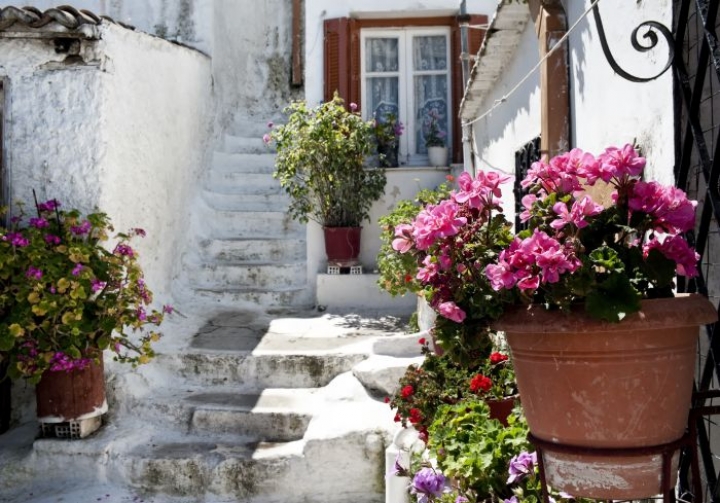
It's a warm sunny morning, and you're taking a walk in the center of Athens in search of the best neighborhoods in the city.
From Monastiraki Square's vivid and colorful market, your steps lead you towards the hill of the Acropolis, and the city's noise starts giving way to the serenity of the charming Plaka neighborhood.
As you wander its narrow streets, you start losing track of time, and you suddenly find yourself going up against paved steps that lead you to a magical place.
Welcome to Anafiotika, a hidden piece of Greek islands right in the heart of Athens!
On the northeastern side of the Acropolis hill, at the borders of the Plaka neighborhood, the tiny district of Anafiotika enjoys a great location and is arguably one of the best Athens neighborhoods.
The area owes its architectural uniqueness to its founders, a small group of builders from the Cycladic island of Anafi, who arrived in the Greek capital during the 19th century to help reconstruct the city and build a place to stay in Athens.
Over the next few years, the workers from Anafi kept building more and more houses for themselves and their families, despite the law against it, and restored the area's two churches, the Church of Saint Simeon and the Church of Saint George of the Rocks, which, as its name implies, is made entirely out of rocks from the hill of the Acropolis!
During the construction of Anafiotika, the builders from Anafi tried to make the area look like the homes they left behind and did a remarkably good job at it!
If you've ever seen what a Greek island that belongs to the island group of the Cyclades looks like, focusing on its architecture, you'll be able to see the similarities with the neighborhood of Anafiotika right away!
The beauty and traditional aesthetic of the area, its relaxed vibes, and its proximity to the city center have made Anafiotika the perfect escape destination, both for travelers and local Athenians alike!
Apart from tourists and locals, over the years, the area has also been frequented by dozens of photographers and journalists visiting the place to document the associated events.
In fact, there has been a lot of hustle around Anafiotika almost ever since the 1950s!
Amid the 20th century, due to archaeological excavations that took place on the hill, a big part of the district was, unfortunately, demolished, and its inhabitants were forced to seek homes elsewhere.
Many of the buildings were also expropriated by the Ministry of Culture, leaving Anafiotika with only 45 houses listed for preservation, still inhabited to this day.
The remaining families have formed a tightly bound community that is determined to preserve its heritage.
That means that, unfortunately, the neighborhood of Anafiotika is out of the question when looking for places to stay in Athens and boasts no boutique hotel or any other type of tourist accommodation.
There are many ways to access Anafiotika, but the easiest is through the Plaka neighborhood.
Follow Stratonos Street, and you'll reach the Church of Saint George of the Rocks. Next, you'll find a set of steps leading up to what seems to be a dead-end, but what is actually the path to Anafiotika?
If you get tired as you walk up the steps, take a moment to stop and admire the unique view of Lycabettus Hill, situated right across from the Acropolis.
Gather up some strength and keep going, as the place that awaits you at the top is truly one of a kind!
No wonder this unique, traditional neighborhood is one of the most beautiful and picturesque places you can find in Athens, making it a mandatory stop during most of our Athens tours.
The small white houses, some of which are carved directly out of the hill, with their bright blue windows, the paved alleys and stairways, and the smell of trees and flowers, truly make you forget you're still in the middle of the bustling capital of Greece.
An old lady watering her plants, the smell of homemade food coming from an open window, or a cat lying down under the sun are only a few of the moments you can experience while exploring Anafiotika.
They will surely remind you nothing of a big hectic city, but more of a tiny little Greek village somewhere far away in the Greek countryside.
Petralona

Petralona is one of the most aesthetically pleasing and hip of central Athens' neighborhoods, located north of Tavros and Kallithea districts and extending from Piraeus Street to Philopappou Hill and from Hamosternas Street to Poulopoulos Bridge.
With its apparent urban vibe, it has arguably been established as a local favorite for drinking, eating, or leisure wandering. And it can be the perfect place if you want to choose and alternative, modern hotel.
That is the reason why it is also popular among visitors to Greece during their stay in Athens, whether they're visiting Greece in winter or summer.
The district took its name in the olden days from the fields (alonia) filled with stones (petres) that were created when the rough terrain was normalized.
The pieces of stone were thrown, and thus, stone alloys were created, which gave their name to the area.
Before the name ‘Petralona’ it was called "The Katsikidika" ( The Goats’ Place) because shepherds wandered around the area with their goats, selling their milk.
Since 1920, this has been banned for -obvious- public health reasons.
But enough with the history lesson; let’s talk about the real question: Is Petralona worth the hype? And if so, what makes it different from every other of Athens' neighborhoods?
To start off, we should focus on the practical aspect of accommodation. For those dedicated devotees of Airbnb, Petralona is an excellent choice for a number of reasons.
It has all the pros of a central area without any cons. In the middle of Athens, the rest of the city, such as Syntagma Square, is easily accessible without the overcrowding that you may feel in the historic center.
Additionally, many of the apartments available for rent in Petralona are of a very high standard, combining the urban reality with tradition.
Last but not least, you can find some fantastic places to eat and/or drink, safe in the knowledge that you will be within walking distance from your place should you have a glass of wine or two!
As mentioned, Petralona is in the middle of nowhere, so getting to your desired destination shouldn’t be too hard. Here, we can show you the quickest way to get to the key sights that every traveler will likely want to visit.
If you want to go to the Acropolis, as you should, you will need to take the underground from Kato Petralona Station and take the Metro line 1 in the direction of Kifisia.
After just two stops, you will arrive at Monastiraki Station, from where you will have to walk for around ten minutes, and voilà! You’re there!
You will need to take the same route if you want to go to Monastiraki Square, minus all the walking, and if your destination is the square of Syntagma, you will also have to walk for around ten minutes.
Of course, there are other ways to get there, some without walking at all, but they will take double or triple the time,
and it really isn’t worth it. See it this way: whilst visiting a magnificent country, you will also achieve that beach body you’ve always lusted after!
Petralona, a lively center with plenty of tavernas, bars, and cafes, has managed to preserve its traditional, vintage style while also incorporating a contemporary aesthetic.
Perhaps not as well frequented by the many visitors who visit Athens each year, Petralona is a neighborhood worthy of your time and exploration.
Koukaki
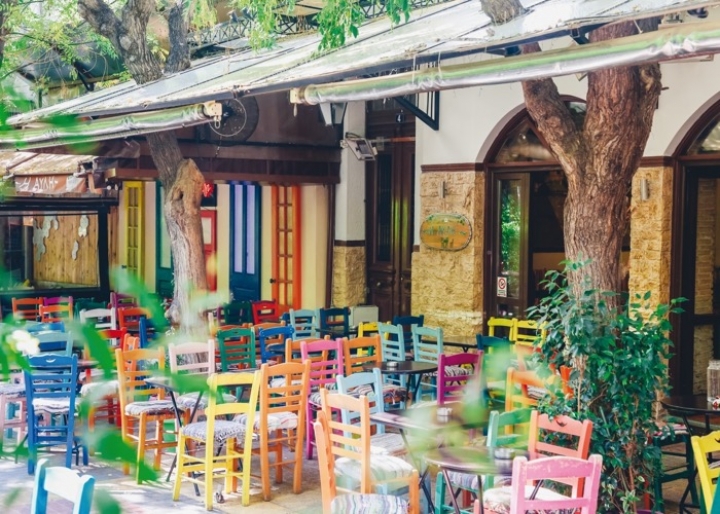
The neighborhood of Koukaki is just a short walk from Athens' picturesque old town and lies in between the Acropolis and Syngrou Fix metro stations.
It may not be as quaint as Plaka, but Koukaki offers an alternative vibe that makes it utterly charming and boasts boutique hotels while it has immediate access to the Acropolis.
Koukaki is one of those Athenian neighborhoods that you may be tempted to skip as a visitor just because you're running short of time and the reputation of other neighborhoods overshadows it.
However, if you are looking for the real deal and the best of what Athens has to offer, we highly advise you to try to fit in a morning, afternoon, or night in Koukaki.
A stroll through its narrow streets and discovering its many art galleries and eccentric shops is only a small fraction of what Koukaki really has to offer.
That's right; there are plenty of things to see and experience in Koukaki at all times of the day!
With a wide variety of eateries and bars, Athens's quirky and artistic neighborhood remains an underrated gem, and exploring it rightfully earns a spot on the list of the best things to do while in Athens.
You can be sure that each part of Koukaki has something original and interesting that you will want to experience!
Kolonaki
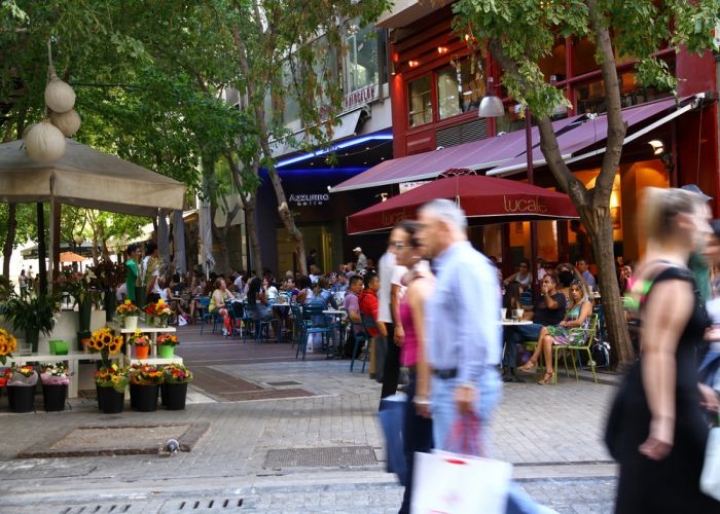
Kolonaki is one of the most historic and best Athens neighborhoods.
It’s a district that covers a huge area, from Syntagma Square and Vasilissis Sofias Avenue to the edges of Lycabettus Hill, which means it is within walking distance from all of Athens' key points of interest.
Kolonaki, which translates to 'little column' in Greek, has taken its name from a little column that can be found in the center of its square.
In modern Greek history, Kolonaki is considered the most aristocratic district of Athens, with neoclassical mansions, sidewalk cafes, and classy contemporary art galleries.
This is due to its strategic location, which is within walking distance from the building of the Greek parliament.
The region is also known for hosting the most important Greek businessmen for a business meeting or coffee after work.
Nevertheless, that's not all there is to Kolonaki.
This luxurious neighborhood offers one of the greatest shopping markets in the city, with its streets decorated with hundreds of unique high-end shops hosting famous Greek fashion designers.
However, be careful; if you wish to shop in Kolonaki, you might have to break the bank, as the prices tend to be pretty steep.
Apart from its shopping scene, in Kolonaki, you can also find many bistros, bars, and restaurants, and even some that boast a rooftop terrace for incredible city views.
Depending on your budget and preference, you can research a luxury or a more affordable restaurant in the region online.
Our advice for visiting Kolonaki would be to make sure to visit Charitos Street. Charitos Street is a narrow, picturesque street where you can find all sorts of restaurants and bars for delicious food and drinks.
The bars there are housed on the ground floor of apartment buildings, and due to them being close to one another, the atmosphere reminds us of a Greek island!
Good music and affordable prices make this narrow street a local favorite hidden treasure. It's one of our favorite Kolonaki streets, and we find it to be a really special and authentic place!
Kolonaki is one of the most luxurious and stylish neighborhoods of central Athens, far away from the tourist traps and a place that is definitely worth your visit regardless of your budget.
Browse its streets, sip your drink in one of its cozy bars, and have the time of your life like a true local! You can always use our Athens travel guide.
Athens' Squares
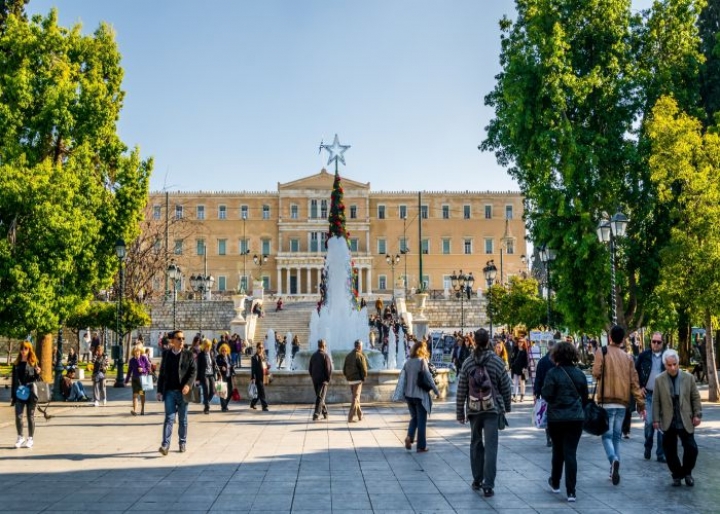
Athens neighborhoods are brimful with gorgeous squares that gather both the locals and visitors of the capital daily.
The most important squares in Athens city centre include Syntagma, Monastiraki, and Omonia, commonly referred to as the 'Commercial center or triangle of Athens' due to their positioning on the map, which forms a triangle.
Klafthmonos, Iroon, Agias Irinis, Kotzia, and Avissinias are smaller in size but equally interesting to the keen traveler.
We love all these squares for different reasons, and you will see why in more detail below.
What's more, it is possible to discover all of them on foot in a single day, since the walk between them takes no more than fifteen minutes.
The order of presentation below is meant to be a walking route starting from Syntagma amid the city centre and ending up in Avissinias, and has nothing to do with size or importance.
Take your camera, coffee, and comfy shoes, and off we go!
Syntagma Square
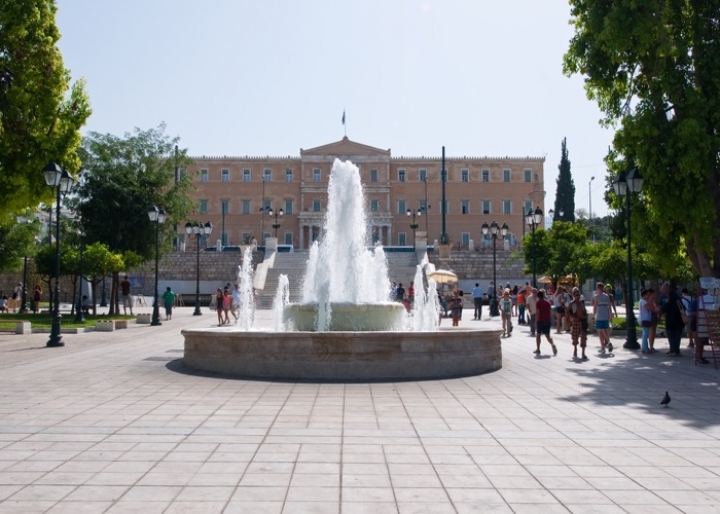
First time in Athens, and you need to know where to start your city exploration. Syntagma Square is the obvious answer to your question!
The emblematic square lies in the very heart of the city of Athens, stretching before the symbol of the Greek State, the Hellenic Parliament.
It is the second largest square in Greece (after Spianada Sq. on Corfu island) and slightly larger than St. Peter’s Square in Vatican City.
It is named Syntagma Square, which can be translated in English as 'Constitution Square,' and it is surrounded by monuments reflecting the vast and turbulent history of Greece in general and Athens in particular.
Follow us on this trip and learn how much history can be found in one spot at the most central point in the bustling city of Athens!
A Brief History of the Square
Despite today’s fantastic location, during antiquity, this area was at the fringes of the city of Athens.
If we could time-travel back in time, we would probably see the ancient river Eridanus flowing towards the ancient cemetery of Kerameikos and the walls of the city standing in front of us.
The ruins of the latest walls can be found right next to the Parliament’s building, dating back probably to the reign of Emperor Valerian.
Most of the things we know about the ancient history of Syntagma Square come from the excavations that happened for the construction of the Athenian Metro system.
The whole area was excavated and a plethora of artifacts, such as funerary goods, shrines, silos, pottery workshops, graves, roads, part of the ancient Athenian aqueduct, and public buildings, were carefully documented and enriched our perception of ancient Athens.
A small ancient inscription at one corner of the square, dedicated to the Muses, stands as a reminder of the ancient past.
During the late Ottoman times, Syntagma Sq. was still outside of the city. The area though was quite popular due to the presence of a spring that supplied the city with fresh water, known as Boubounistra, and was constructed of marble blocks collected probably from a public building of Roman times.
After the War of Independence and the establishment of the new Greek State, the newly appointed King of Greece, Otto, declared Athens as the new capital of the Kingdom of Greece.
Then, the area of Syntagma, then known as Perivolakia (roughly meaning 'gardens'), was chosen as the construction site of the Royal Palace (today’s Parliament).
Originally, the square belonged to the palace's premises along with the Royal Gardens - the National Gardens as they are referred to today.
For its decoration, the Lord of Bute offered to King Otto and Queen Amalia five bronze statues depicting gods, athletes, and animals.
The original ones were found during the excavations at Pompeii and Herculaneum, and the copies were cast in Vienna.
Only one statue on Syntagma Sq. belongs to a Greek sculptor, the Young Man Eating Grapes, a work of Demetrius Philippotes.
The reign of King Otto was not as progressive as the Greeks wanted it to be.
The young King, following the advice of his counselors, chose to follow a strict rule, accumulating the country's political power on him.
Eventually, the people of Athens, supported by heroic figures of the Greek War of Independence, questioned the royal couple's authority with the civil guard's help.
It was September the 3rd of 1843 when the people of Athens occupied the Square and demanded from the King to form a Constitution for the country.
After those events, Otto was forced to give in to the people’s demands, and from then on, the Square of the Palaces became Constitution Square.
Attractions Near Syntagma Square
The location of Syntagma Square in the most central part of Athens means that it is within walking distance from some of the most significant and popular attractions and ancient sites of the capital city.
Right next to the central building of the Greek parliament and close to the ‘Syntagma’ metro station, you will find the luscious National Gardens.
There, you will breathe in the fresh air from the impressive selection of trees and plants from around the world.
Next to the National Gardens lies the Panathenaic stadium, also known as Kallimarmaro, the UNESCO World Heritage Site that hosted the first Olympic Games of the modern Greek state.
Continuing in the same direction, you will come upon the impressive Temple of Olympian Zeus. It was built with the aim of being the largest temple in ancient Greece and succeeded in its goal.
500m from The Temple of Olympian Zeus lies the famous Acropolis rock, and the modern Acropolis Museum is across from it.
Moreover, the famous Ancient Agora is northwest of the Acropolis and, therefore, within a short walk from Syntagma.
Climb the imposing rock and marvel at the thousand-year-old monuments, such as the Odeon of Herodes Atticus, the Propylaia, the Parthenon, and the Erechtheion.
In order to explore the Acropolis and the Acropolis Museum to their full potential, you can enjoy a Private Mythology Tour of the Acropolis and Acropolis Museum.
A few blocks from the central square with the tree-lined streets but in the opposite direction from the Acropolis, you will also come across the famous and fascinating Benaki museum.
Benaki Museum is one of the most popular and favored museums in Athens, with many branches, such as the Museum of Cycladic Art, spread across the city to the southern suburbs.
If you're into culture, local tradition, and heritage, visiting the Benaki Museum is a must!
Agias Irinis Square
Agias Irinis Square - credits: athensguide.com
Agias Irinis Square is one of the most beautiful in our city.
Itis an ideal destination in the morning for coffee and brunch, but also for a nice dinner in trendy restaurants that refreshing cocktails and drinks will follow.
It is a lively area you won't resist falling in love with.
On Aiolou Street, just a breath away from Monastiraki but also from Kolokotroni and Ermou Street, this square shows an alternative face of Athens that the youth of the city wholeheartedly supports.
In addition to stylish cafes and bars, alternative and casual, you can find places that organize theatrical events, restaurants with tasty innovative proposals, and quality street food.
Klafthmonos Square
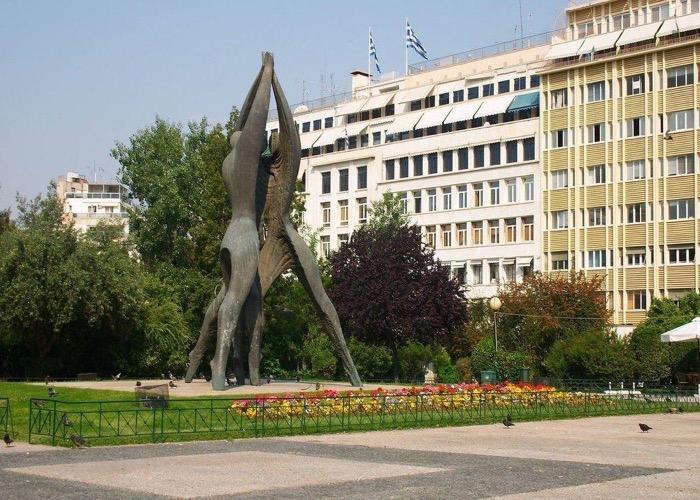
Coming down from Panepistimiou str. (also known as Eleutheriou Venizelou str.), you will pass by the beautiful Athens trilogy of neoclassical mansions designed by the Hansen Brothers in the late 19th century, and on your left-hand side, you will see Klafthmonos square.
The name of this square, so difficult even for Greeks to pronounce, translates to 'Cry.'
It stuck after Estia magazine used it for the first time back in the late 19th century to describe the protests of the civil servants in front of the Ministry of Economy, who were let go every time the political party in power changed to give their place to the voters of the winner.
Efforts have been made to change the name to something less dramatic, like National Reconciliation Square, after the Monument of the same name in the center of the square by Greek sculptor V. Doropoulos, but to no avail.
The reason we love this crying square is the lovely Museum of the City of Athens, where you can learn all about the city's history since 1834, when it first became the capital of Greece.
A visit to the lovely Black Duck Bistro in the museum's garden is also highly recommended.
The area behind Klafthmonos Square is very busy with bars and cafés, including The Clumsies, which, like our square, is not true to its name, and in which you will try some of the best brunches in Athens or late-night cocktails the city has to offer.
Omonoia Square
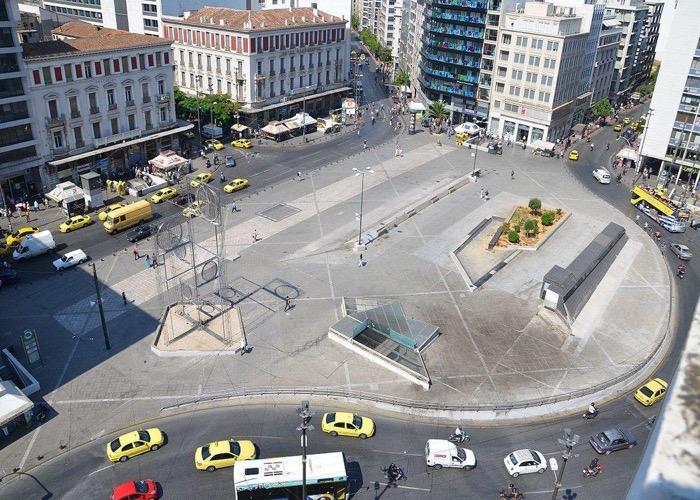
Omonia Square is a busy intersection between Panepistimiou, Stadiou (both these will take you to Syntagma), Athinas (that will take you to Monastiraki), Peiraios (will take you to the port), Agiou Konstantinou (will take you to the national highway towards Peloponnese) and 3rd Septemvriou streets.
Its name, Omonia, translates to 'concord' and was given back in 1862 after two opposing political parties agreed to stop hostilities with one another and in favor of peace.
Today, Omonia is very busy, hosting some of the most important Athens landmark buildings, such as the Mpageion Hotel, and with the Central Meat and Fish Market in close proximity, as well as the popular spice street Evripidou, which should be on every visitor's itinerary.
Omonia is also the place you’ll walk by on your way to the National Archaeological Museum of Athens, the biggest and most important in Greece.
If you are young at heart and a little bit restless, then a visit to the Exarchia neighborhood is in order.
In a neighborhood with a reputation for rebellion and non-conformity, these traits are not only to epochs of political unrest but also to the unique cafes and bars of the area.
We suggest a visit to Fabrica de Vino, for wine lovers and to Taf Café, for those who appreciate a well-made flat white (complete with latte art and a smiling barista) above all else. Both are situated in Emmanouil Mpenaki str.
Kotzia Square

With a somewhat simpler backstory, this main square's name comes from a former mayor of the city of Athens, Konstantinos Kotzias.
It's one of the most beautiful on our list, with the impressive neoclassical architecture of Athens apparent all around.
Right in the front of the square, you will see the Townhall of Athens, complete with the statues of Pericles and Solon on each side.
This square also has an archaeological interest since it used to be part of the Acharnian Way, which was going all the way to Acharnai, one of the ten municipalities of ancient Athens.
Today, some of the ruins have been excavated and are visible from street level.
While in the area, take a chance to visit the famous Krinos café, dating back to 1923, and try its traditional loukoumades -hot, honey-soaked donuts served with cinnamon.
Their taste and aroma are sure to ruin plain, chocolate-glazed donuts forever, but we swear it's worth it!
Iroon Square
Iroon Square, Psyri - credits: Milan Gonda/Shutterstock.com
The smallest and, at the same time, the friendly and picturesque district is located in the heart of the capital with the most beautiful picturesque buildings, but also small shops, which are waiting to welcome each visitor.
It is the district of Psiri, located in the capital's historic center.
It spreads around ‘Psiri Square,’ also known as ‘Iroon Square,’ which translates to ‘Heroes Square.’
Many famous people have lived in the area throughout the years, from Lord Byron and the fighters of '21 to Greek writer Alexandros Papadiamantis.
Nowadays, Iroon Square is a picturesque and historic square full of shops, restaurants, taverns, and bars.
Every year, it is filled with thousands of visitors from Greece and the world with the ultimate goal of admiring its unsurpassed beauty and going back to those beautiful years of simplicity and carefreeness the old-time charm of Iroon Square offers.
Monastiraki Square
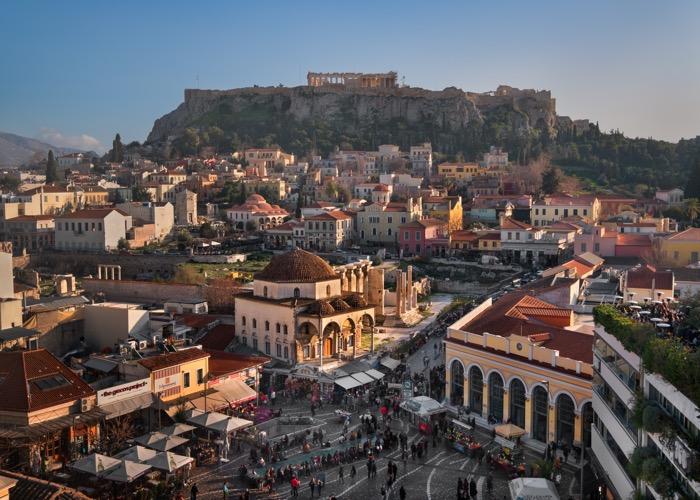
If there’s one place where almost the whole history of Greece -and of Athens- throughout the years is hauntingly present, this is Monastiraki Square.
A can’t-miss spot of the city of Athens, Monastiraki Square was -and still is- a boiling cauldron of people, ideas, civilizations, and religions.
Perhaps the oldest surviving square of the city, it has faced numerous changes and has surely witnessed the city's evolution since ancient times.
The pivotal importance of Monastiraki Square in the city's urban development is apparent when looking at the magnificent buildings that flank it on every side, dramatically blending the present with the past.
Monastiraki Square was recently renovated with mosaic blocks of marble, carved stone, and cast iron, symbolizing the "flows" and the variegation of Mediterranean people.
Right after the declaration of Athens as the capital of the newly-born state of Greece in 1834, the progressive politicians of the time started a discussion within the Parliament to construct an urban railway system that would follow European standards.
The immediate need, they argued, was the connection of the port of Athens, Piraeus, with the city center.
After years of debate and political unrest, constructing the first urban railway in Greece became a reality in 1867, connecting Piraeus to Thisseion.
Soon after, the project expanded to the city center, and the Station of Monastiraki was inaugurated in 1895.
Stefanos Psychas, a wealthy banker of the time, provided the money for the construction of the station, taking responsibility for the project from the government.
The outline of the building and its architectural details were carefully selected to satisfy the aesthetics of the time and to follow the technological standards already available in Europe.
Today, the station stands as an example of Neoclassicism, equipped with high-standing arches that allow the sunlight to illuminate the interior of the station’s hall.
The Tzistarakis Mosque
Located on the right of Monastiraki Metro Station, the mosque of Tzistarakis Aga stands as a symbol of Ottoman rule over the city of Athens.
Tzistarakis was the appointed voivode (Ottoman ruler) of Athens who decided to erect a mosque in 1759 on the square of the Bazaar, as this square was formerly known.
There is a story, though, that accompanies the mosque through the years. Legend has it, that Tzistarakis ordered the demolition of an ancient column from the Temple of Zeus (most likely from the Library of Hadrian) to make plaster to whitewash the walls of his brand-new mosque.
Unfortunately for him and the rest of the city, a terrible plague the coming year decimated the population of Athens, and everyone accused Tzistarakis of that incident.
The folk tradition claimed that every piece of ancient material is imbued with spirits and ghosts, never to be disturbed.
The action of Tzistarakis evoked the anger of the spirits, who took revenge by sending the plague to the city.
Eventually, Tzistarakis was captured by the order of the Sultan and was sentenced to death by decapitation.
Following the establishment of the New Greek State, the Mosque was converted into an armory, a prison, and even a storage room.
After its restoration, today, the Mosque houses part of the Greek Museum of Folk Arts with really interesting collections vividly painting a picture of an era long gone.
The Library of Hadrian
Located right next to the mosque of Tzistarakis, the Library of Hadrian is the most impressive ancient building to be found on the square.
As part of Emperor Hadrian's ambitious construction program, it was built in 132 CE next to the existing Roman Agora of Julius Ceasar and Emperor Augustus.
When finished, it was one of the most lavishly decorated buildings of ancient Athens and the largest library in Athens. Pausanias, the famous traveler, visited the Library and wrote about it:
“... Hadrian constructed other buildings also for the Athenians: {...} the most famous of all, a hundred pillars of Phrygian marble. The walls, too, are constructed of the same material as the cloisters. And there are rooms there adorned with a gilded roof and with alabaster stone, as well as with statues and paintings. In them are kept books.” Pausanias I, 18.9
The most impressive part of the building that survives today is its western facade. The variety of the materials used there shows the great expense of the project. The wall was made out of Pentelic marble, while the columns of the propylon (entrance) were made out of Phrygian marble, imported from the imperial quarries.
The rest of the columns were also provided by the imperial quarries of Karystos, and, most likely, they were used to support statues of Nike.
The back wall of the library was the location where the precious scrolls and books used to be kept.
The whole complex included auditoriums, reading rooms, as well as a long pool in the center, creating a tranquil environment appropriate for the building’s function.
Unfortunately, in 267 CE the invasion of the Herulians destroyed the building and the Athenians never succeeded in restoring it to its former glory.
After the domination of Christianity, a church was built where the pool of the Library used to stand.
The Monastery of Pantanassa
On the corner of Monastiraki Square, lies a small church dedicated to Virgin Mary Pantanassa. Scholars debate on the date of the construction of this church, but prevailing theory suggests that it was erected in the 10th century CE.
This ancient church used to be the church of a nunnery that took up the whole square, thus the reasoning behind the square's name!
During the Ottoman years, the little church belonged to the powerful monastery of Kaisariani, and in the 17th century, an extensive restoration program changed the Byzantine church drastically.
In the recent past, the Church of Pantanassa was restored as closely as possible to its original form and still operates as one of the most historic, ancient churches in Athens.
If you look at the open space almost at the center of the square, you can see one of the ancient rivers of Athens still flowing!
Eridanus used to pass through the city of Athens up until the Roman times, when it was decided to be covered with a tunnel.
During the excavations for the Athens Metro, the ancient river was discovered alongside a plethora of priceless artifacts from the city's vast history!
Monastiraki Square is arguably a place of wonder, from ancient rivers and huge libraries to thousand-year-old churches, and cursed mosques.
Start your exploration of Athens from this Monastiraki Square and trace your own piece of history while choosing your way under the shadow of the Acropolis Hill.
Dozens of small shops clustered on Ifestou Street (right next to the station) sell furniture, appliances, clothing, shoes, beads, used trays, decorative items, tools, and anything else you can imagine.
Every Sunday morning at the flea market of Abyssinia Square, you will have the chance to find treasures among hundreds of old objects.
The centrally located flea market of Monastiraki is also an excellent place to buy your souvenirs. Dust off your haggling skills and drive a hard bargain. Don’t be shy, it’s expected!
Please keep in mind that near Monastiraki Square lies Athens Central Market, so if you're a foodie, make sure to save some time for a visit there as well!
Avissinias Square

Avissinia was the common name for Ethiopia back in the early '20s. The reason an African country so far away gave its name to a little square in the heart of Athens is unclear.
However, it is believed that this took place as a result of the financial aid commissioned by the regent of Ethiopia at the time, Haile Selassie, to poor Greek immigrants who were forced to abandon their homes and fortunes in Asia Minor as an aftermath of the Catastrophe of Smyrna, and make a new life in mainland Greece.
The locals refer to it also as giousouroum, after the family name of one of the first and most prominent merchants who made his fortune here after having left Smyrna.
This little, central square is nowadays a window onto a world long gone. Merchants sell antiques, old coins, vinyl records, books, jewels, clothes, and everything else you can imagine.
True to its 1910 purpose, this square remains an Athens flea market for second-hand goods, and it looks exactly like it must have looked 100 years ago.
Come here on a Sunday to make the most of your visit, as it's on that day that the giousouroum is most active.
If the atmosphere here suits you, make sure to try the local cuisine in the nearby picturesque Café Abyssinia, with live music on the weekends.
And if your love for second-hand clothes and accessories goes deep, cross the main shopping street, Ermou Street, for a visit to Kilo shop and Concept Store, where bargain meets style.
Athens' Architecture

Downtown Athens is mostly known around the world for its classical period ruins, such as the Parthenon, the Erectheion, the Temple of Hephaestus in the Ancient Agora, and so on and so forth.
But how about the excellent specimens of neoclassical architecture it boasts, situated in the very heart of a modern city? Doesn’t it ring any bells? Well, let us enlighten you then.
Neoclassical is the type of architectural and artistic movement that bloomed around the 18th and 19th centuries in Europe and elsewhere as an effort to revive the classical forms of Greek antiquity and the subsequent Roman Empire.
In Greece, this type of architecture was very popular in the 19th and early 20th centuries, with many examples still standing today.
Such are the numerous neoclassic mansions in Plaka, our Parliament building, the old Parliament House, which is now the National Historical Museum, the Zappeion Mansion, and of course, the best examples of all: The Athenian Trilogy in Panepistimiou str., including the National Library, the University of Athens and the Academy.
The National Library of Athens
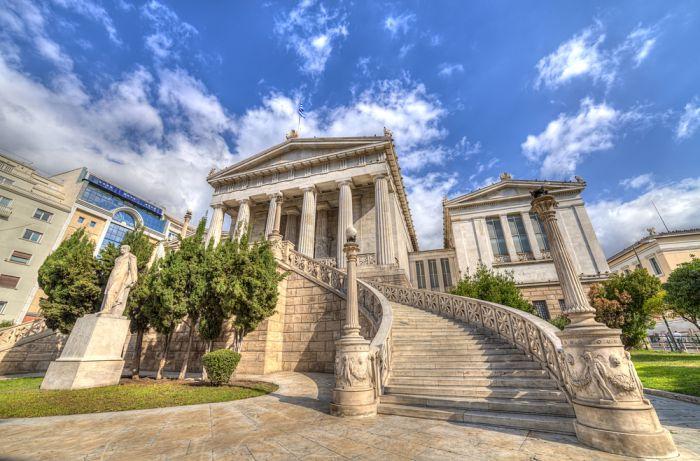
Situated on the far left end of the complex, the National Library was designed by the Danish architect Theophil Hansen and constructed between bewteen1888 and 1902.
It has elements of the Doric Order, characterized by its austerity of form, simplicity, and clear-cut lines, as well as a double Renaissance-type staircase leading to its impressive entrance.
The famous white Pentelic marble -coming from Mount Penteli- that was used in the construction of the masterpieces of the 5th century BC was also used in the making of the National Library 2,300 years later. Talk about continuity in art!
And what about the serious-looking statue that holds such a central position at the base of the building?
It is Panagis Valianos who, along with many other benefactors, financed and donated the National Gallery to the Greek state.
Until 2017, the National Library held nearly 2,000,000 books and periodicals and over 4,500 manuscripts.
Nowadays, the historical building has closed its doors to the public, but the contents remain an open archive through the facilities of the Stavros Niarchos Foundation Cultural Center.
The University of Athens

The University of Athens -or Panepistimion in Greek- lies at the heart of the Trilogy.
It's the first one to have been constructed, back in 1864, and also the reason behind Panepistimiou Street's name -which translates to 'University Street'- and the metro stop, Panepistimio right outside.
It's the only one out of the three to have been designed by Christian Hansen, brother to Theophile, the original architect of the other two.
Nowadays, the building houses administrative offices, but it's also where official and graduation ceremonies for all the different departments of Greece's first and oldest university, the National And Kapodistrian University, take place.
This building is another example of neoclassical architecture, but it sports a somewhat simpler style compared to the other two. Around the entrance, you can see five different statues of men.
The first one depicts the philhellene William Ewart Gladstone, a symbol of close ties between Europe and Greece.
The second one depicts Adamantios Korais, a leading figure during the Greek Enlightenment and also an important scholar and writer.
The third one depicts Ioannis Kapodistrias, the first governor of Greece and a very charismatic political figure after whom the university is named.
The fourth depicts Rigas Feraios, a writer and political thinker who played a major role in the spirit of the country and died in the War of Independence against the Ottoman Empire.
The fifth and last statue depicts the Patriarch of Constantinople, Gregory the Fifth, who was sent to the gallows by the Ottomans as a result of the Greeks' revolt against their rule in 1821.
The Academy
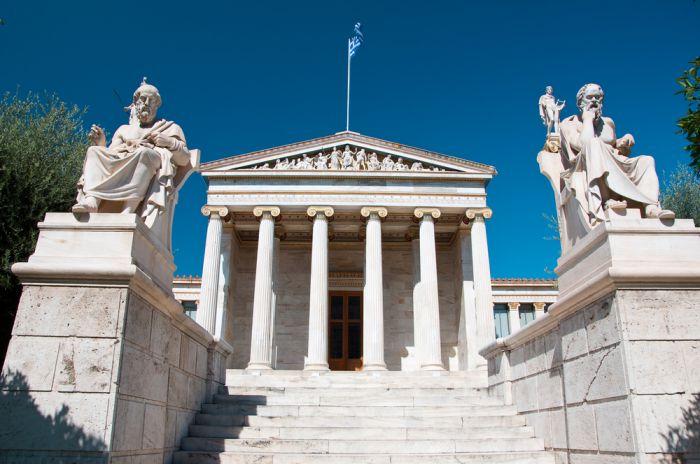
Another building on our list is the Academy of Athens.
It was constructed in 1859-1885, and it's a result of the combined efforts and inspirations of architects Theophile Hansen and Ernst Ziller, as well as the sculptors Leonidas Drosis and Christian Griepenkerl.
Again, fine Pentelic marble was used here, while the main source of financing was a rich family by the name of Sina.
The Academy is built in resemblance to the Propylaea of the Acropolis (the entrance to the sacred hill), and it's considered by many the best example of neoclassical architecture in the world.
Inside the building is an extensive mural depicting the myth of Prometheus painted in chronological order to inform the viewer of the story narrated by Aeschylus in his famous homonymous tragedy.
On each side of the building, we see Plato and Socrates, the two great philosophers who, along with Aristotle, laid the foundations of Western thought and civilization.
Rising higher than the roof itself, the ancient protectors of Wisdom and Light, Athena and Apollo, watch tirelessly over their ancient city and their former subjects, still protecting and enlightening us in our endeavors, hopefully not begrudging our changed ways.
The Benizelos Mansion: The Oldest House in Athens

The oldest house in Athens tells a story of the life of Athenian aristocrats before the Greek Revolution and paints a picture of their traditions and habits.
That being said, there is another story that this old house tells: one of great humanity and faith.
It is the story of a Greek woman who faced all the possible challenges but was determined to fight for what she believed in and protect the vulnerable who had no means of defending themselves.
The Benizelos Mansion has been identified as the oldest house in Athens and is located in Plaka, Athens’ beautiful old town and historical center, at the foot of the ancient Acropolis.
This mansion was built in the 16th century and is a testament to the eloquent architecture that the Ottoman Empire brought along with its occupation.
Today, the mansion has been restored and turned into a museum that is open to the public four days a week. You can see details about opening hours on the official website.
Tip: You can visit the Benizelos Mansion in one of our tailor-made Athens tours.
The whole building is an exhibition that maintains elements of many different eras. For example, archeologists found the remains of the Roman City Wall 15 ft under it!
It is a great example of Ottoman-style architecture with a loggia, open outdoor archways, marble archways, T-shaped verandas, an interior yard with a well, and an olive press.
It is a two-story building that was overtaken by the Greek Ministry of Culture in 1972 and was given to the Holy Archdiocese of Athens in 1999. The European Union
funded this project and enabled it to be fully restored and made into the cultural museum it is today.
The mansion is beautiful and has a rich religious and cultural history, making it a fascinating place to visit.
The house’s first occupants were Angelos Benizelos and his wife Syrigi Palaiologina. The couple were Athenian aristocrats with Byzantine roots and were initially childless.
However, in November 1522, Syrigi’s prayers to bear a child were finally answered, and she gave birth to a girl.
This little girl, born 'Revoula,' later became the most famous resident of the oldest house in Athens and a pillar of philanthropy known as Saint Philothei. Revoula’s parents forced her to marry her abusive husband at the age of just 14 years old.
She became a widow and an orphan at the age of 17 after her husband and parents passed away, and she inherited a fortune.
She was finally free to live the life of her choosing, and she chose, from that point on, to take on a monastic lifestyle of prayer.
Revoula adopted her new name, Philothei, which translates to 'friend of god' when she established her first monastery.
Today, the name Philothei is celebrated on the 19th of February, and the Athenian district of Filothei is named after her.
St. Philothei used her affluent background to create several charitable establishments, such as schools -where she taught Greek Christian heritage hospices, elderly homes, and monasteries.
These shelters served as a place of worship and as a refuge for Athenians, specifically female slaves under Ottoman rule.
The Holy Martyr was also known for buying the freedom of Greek slaves, which put a target on her back, for she outwardly defied the Turkish regime.
St. Filothei was an exceptional woman and a real feminist; she had a particular concern for the quandary of her fellow women at the time, putting her own safety at risk.
She provided a safe haven for young women and girls who were often victims of violence and injustice under Turkish rule.
St. Philothei’s actions did not go unpunished. She was beaten and imprisoned by the Turkish Regime on multiple occasions, but none of this held her back: she continued to defy the rulers by saving the young girls held in captivity and by teaching Christianity.
Eventually, however, at age 67, St. Philothei attended a church ceremony that was raided by Turks who seized her and beat her gravely.
She was bedridden for four months before dying of her injuries; 10 years later, St. Philothei was canonized and enlisted as one of the blessed and holy women of the Orthodox church.
The Benizelos Mansion is now a standing reminder of St. Philothei, an extraordinary woman whose dedication to her people and to her faith cost her her life.
Check out the Benizelos Mansion along with other landmarks of Greece by booking one of our Greece vacation packages. The sky is the limit!
Final Thoughts on Where to Stay In Athens
In conclusion, choosing the ideal place to stay in Athens can greatly enhance your experience of this captivating city.
Whether you're drawn to the ancient wonders near the Acropolis, the lively energy of Monastiraki, or the local charm of neighborhoods like Koukaki and Plaka, Athens offers a range of options to suit every traveler's preferences.
The city's diverse neighborhoods provide unique atmospheres, from historical richness to modern trends, ensuring that your accommodation becomes an integral part of your journey.
By considering factors like budget, proximity to attractions, and the type of experience you seek, you can find the perfect lodging option to create lasting memories against the backdrop of Athens' remarkable history and culture.





